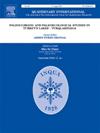The role of Holocene climate dynamics in the modeling of fluviomarine terraces in the northeastern Brazilian coast
IF 1.8
3区 地球科学
Q3 GEOGRAPHY, PHYSICAL
引用次数: 0
Abstract
Fluviomarine terraces comprise mixed sedimentary sequences formed through the interplay of fluvial and marine aggradational morphodynamics. Although they are very common along the vast Brazilian coast, they are currently little explored in the geomorphological literature. In recent official mappings, it is common to observe the classification of the last or predominant event in each sector of the plain, with the discussion of fluviomarine morphologies being little explored. Therefore, this study aims to analyze transitional environments near the Rio Pardo River estuary, located on the northeastern Brazilian coast, within the alluvial-coastal system, which presents complex morphosedimentary archives consolidated during the regressive trend of the Holocene Relative Sea Level. To better understand the genesis, chronology, and vertical sequence that formed these fluviomarine terraces. A morphological description of three stratigraphic profiles exposed on erosive riverbanks was conducted using optically stimulated luminescence dating, sediment grain size characterization, and environmental depositional conditions and pedogenesis process. The results suggest five distinct depositional stages occurred, driven by Holocene climatic variations in the region with close correlation with Bond events and variations of the Intertropical Convergence Zone and South Atlantic Convergence Zone: 1 - Early Holocene ∼10.59 ± 0.85 ka; 2 - Middle Holocene ∼5.30 ± 0.66 ka and 4.57 ± 0.48 ka; 3 - Late Holocene A ∼3.44 ± 0.31 ka; 4 - Late Holocene B ∼2.5 ka; 5 - Modern surface deposits ∼1.93 ± 0.20; 1.59 ± 0.18 and 1.46 ± 0.1 ka. Thus, the fluviomarine terraces analyzed constituted support for the identification of the climatic pulses that occurred in the Holocene along the Brazilian northeast coast.
全新世气候动力学在巴西东北海岸海陆阶地模拟中的作用
河海阶地是由河流和海相沉积动力学相互作用形成的混合沉积层序。虽然它们在广阔的巴西海岸非常常见,但目前在地貌学文献中很少被探索。在最近的官方制图中,通常观察到平原每个部分的最后或主要事件的分类,而对河流海洋形态的讨论却很少探索。因此,本研究旨在分析位于巴西东北部海岸的里约热内卢Pardo河河口附近冲积-海岸体系内的过渡性环境,该环境在全新世相对海平面下降趋势中呈现出复杂的形态-沉积档案。为了更好地了解形成这些海陆阶地的成因、年代学和垂直序列。利用光激发光测年、沉积物粒度表征、环境沉积条件和成土过程等方法,对3个暴露在侵蚀河岸上的地层剖面进行了形态描述。结果表明,在全新世气候变化的驱动下,该地区发生了5个不同的沉积阶段,与Bond事件和热带辐合带和南大西洋辐合带的变化密切相关:1 -全新世早期~ 10.59±0.85 ka;2 -中全新世~ 5.30±0.66 ka和4.57±0.48 ka;3 -晚全新世A ~ 3.44±0.31 ka;4 -晚全新世B ~ 2.5 ka;5 -现代地表沉积物~ 1.93±0.20;1.59±0.18和1.46±0.1 ka。因此,分析的海陆阶地为确定巴西东北海岸全新世发生的气候脉冲提供了支持。
本文章由计算机程序翻译,如有差异,请以英文原文为准。
求助全文
约1分钟内获得全文
求助全文
来源期刊

Quaternary International
地学-地球科学综合
CiteScore
5.60
自引率
4.50%
发文量
336
审稿时长
3 months
期刊介绍:
Quaternary International is the official journal of the International Union for Quaternary Research. The objectives are to publish a high quality scientific journal under the auspices of the premier Quaternary association that reflects the interdisciplinary nature of INQUA and records recent advances in Quaternary science that appeal to a wide audience.
This series will encompass all the full spectrum of the physical and natural sciences that are commonly employed in solving Quaternary problems. The policy is to publish peer refereed collected research papers from symposia, workshops and meetings sponsored by INQUA. In addition, other organizations may request publication of their collected works pertaining to the Quaternary.
 求助内容:
求助内容: 应助结果提醒方式:
应助结果提醒方式:


